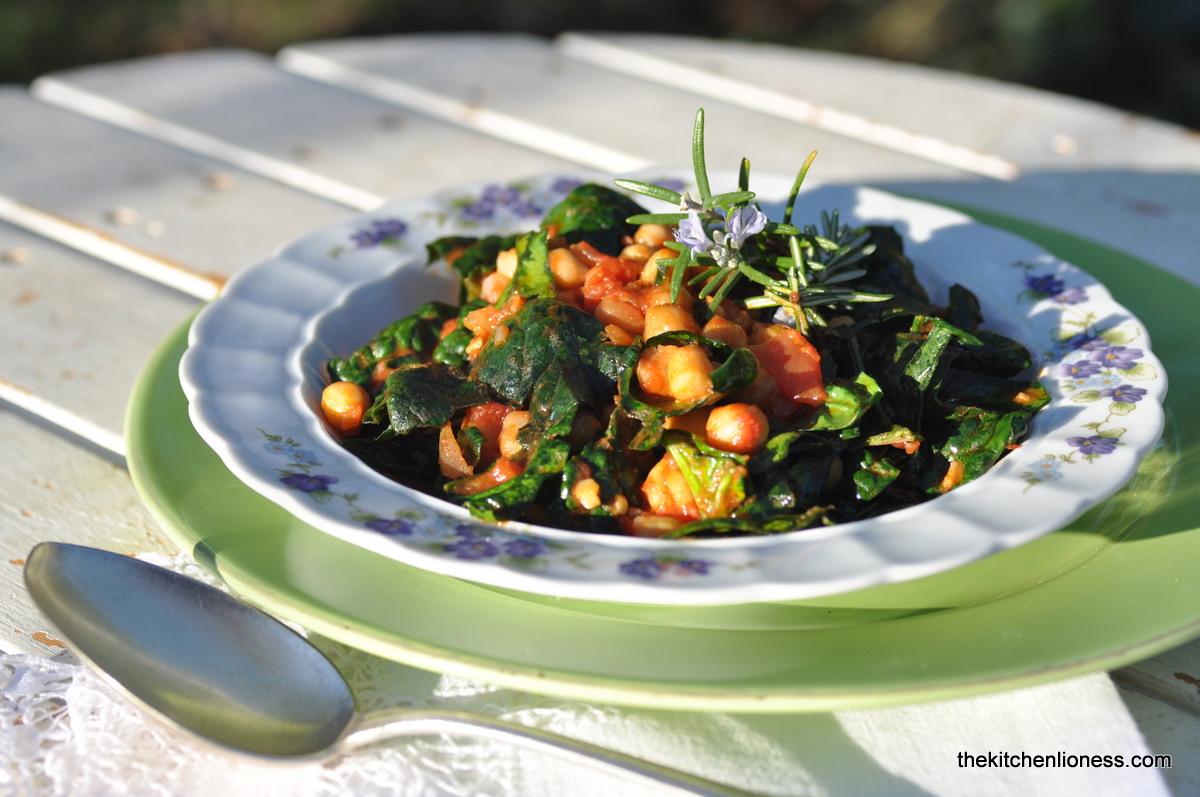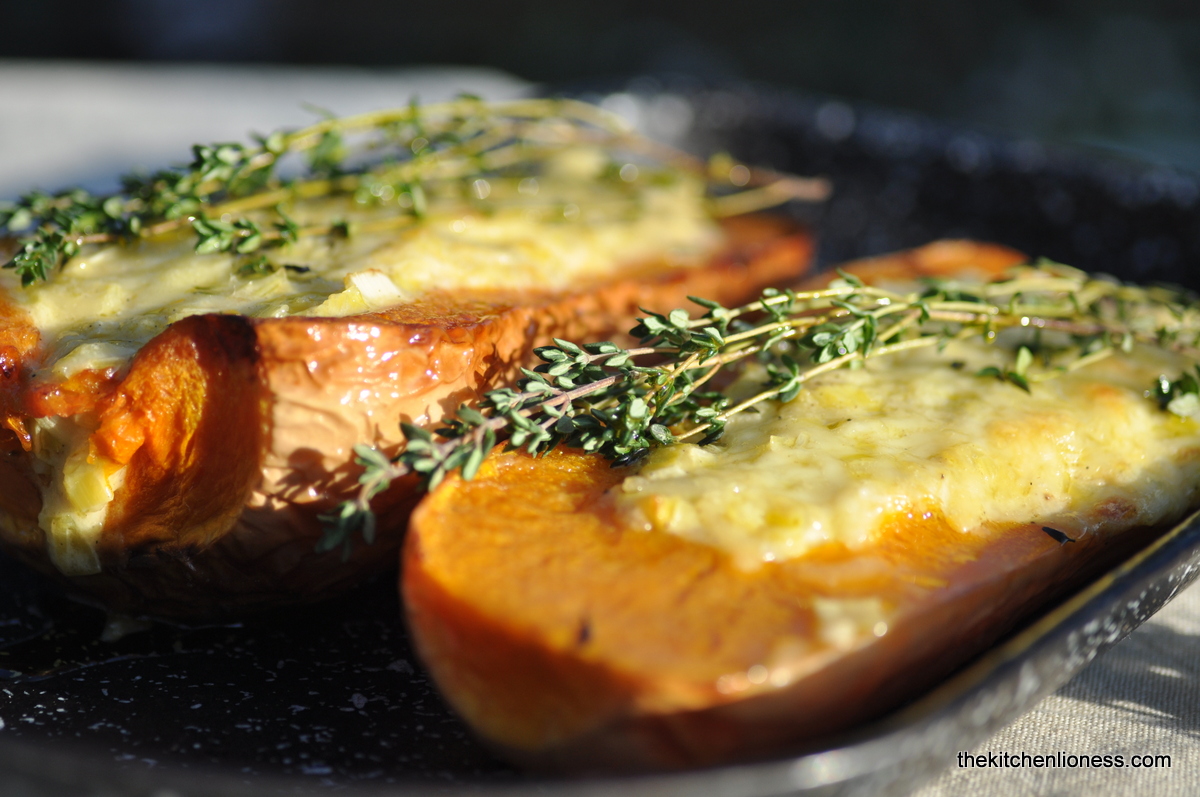The month of January marks the twenty-first month of our international online cooking group, The Cottage Cooking Club. As a group, recipe by recipe, we are cooking and learning our way through a wonderful vegetable cookbook written in 2011 by Hugh Fearnley-Whittingstall, entitled „River Cottage Everyday Veg".
One of the declared aims of our cooking group is to make a decided effort to use as much regional, organic and seasonal produce as is reasonably possible.
This month I prepared eight of the ten designated recipes, plus one extra. I will write about each dish in the order in which I prepared them.
My first recipe for this Januray post is the colorful Chickpeas with cumin and spinach (page 246) from the chapter "Store-Cupboard Suppers“.
Once you have all the ingredients in place, this is a quick dish to put together. An onion gets sautéed with garlic, chili, cumin, and lemon zest. Then you add tomatoes, either freshly grated or good-quality chopped tomatoes from a can. After a gentle simmer for a few minutes, get ready to add the roughly chopped spinach (we still get good fresh spinach from Italy these days) – stir until wilted and then add the chickpeas and warm gently.
What a lovely side dish, with lots of color and flavor and different textures and with just enough cupboard ingredients to make this one easy dish to cook after a busy day.
The second recipe I prepared was a take on one of my favorite and most beloved recipes from the book. The Flat onion bhajis (page 318) from the chapter „Mezze & Tapas“ is a variation of the „Cauliflower pakoras with tamarind raita“ that we made back in September 2014.
The batter for this intriguing appetizer consists of gram flour, baking powder, ground cumin, corinander, turmeric and cayenne pepper, plus some fine sea salt. It has the most delightful warm color. It is true what they say about gram flour varying greatly. I used some organic one which I have used for pancakes before. I know from experience that it seems to need more liquid than the regular gram flour available around here – so I ended up adding more water to the batter than the recipe called for – I just went by the description of the batter having to have a consistency of „double cream“.
When making a battter like this, I always add sparkling water to it instead of regular water – that ensures that the batter is light, airy and renders crispy fried veg in the end.
Thinly sliced and crunched-up onion slices, coated and fried with this very tasty batter and served warm with a cool mango chutney raita – this is a true crowd pleaser indeed. As I could not find the tamarind paste, I went with the optional mango chutney - a cool, tangy yet slighty sweet dip - wonderful alongside the warm, spicy fried piles of onion.
The third recipe that I made this month was the Curried red lentil soup (page 166) from the chapter of "Hefty Dishes“, a variation of the Curried sweet potato soup that we made back in December 2014. This wonderful warming winter soup is cooked with onions, garlic, carrots, celery, grated fresh ginger, red chilies, garam masala, curry powder, red lentils, and vegetable stock (page 130).
After the soup is puréed, you add coconut milk, lime juice, salt and pepper to taste - finish with some lovely Greek yogurt and fresh coriander (I opted for beetroot, alfalfa and leek sprouts instead).
This is such a fabulous recipe. The soup is rich and creamy, with just the right kick from the spices, and just the right amout of sweetness from the red lentils and the coconut milk - all counter-balanced by the tang from the lime juice and the Greek yoghurt. A must try, no doubt!
The fourth recipe I made in January was the Moroccan spiced couscous (page 231), from the chapter „Store-cupboard suppers“. This recipe is a variation of the Quick couscous salad with peppers and feta that we made back in August 2014, and the Tomato and olive couscous that we prepared in June 2015.
The couscous is easy enough to prepare according tot he package instructions – make sure though to add the spices that Hugh´s recipe calls for, namely cumin and coriander as well as cinnamon. Once cooked, fork the couscous with some olive oil, lemon juice, sea salt and freshly ground black pepper. Then add chickpeas, chopped apricots (I opted for gloden raisins instead), toasted chopped almonds and pistachios ans finely chopped herbs – I used parsley and chives as well as a bit of lemon thyme from the garden. A different kind of couscous with lots of different flavors and textures - definitely worth a try.
The fifth recipe this month was the amazing Seared chicory with blue cheese (page 343) from the chapter of „Roast, Grill & Barbecue“ – my personal favorite this month.
Just make sure to serve some lovely crunchy, grilled multi-grain Crostini (page 178 ) alongside and you will be in for a treat.
What an explosion of flavors – this bitterness from the chicory, the smokiness from the BBQ, the saltiness from the Roquefort – truly a dish that you will adore if you enjoy those flavor components. And we did.
The sixth recipe that caught my attention this month was the Squash stuffed with leeks (page 40) from the chapter „Comfort Food & Feasts“. Squash season is coming to an end around here and the choice of squash available is rather limited but my favorite squash to cook and bake with, the butternut squash, is still available – so butternut squash it was for this recipe.
I did veer from the original recipe a bit though – since the squash were so long, I opted for the „open-faced“ version instead of filling the entire squash with the leek mixture. The creamy leek filling is made with leeks, English mustard (available at your favorite British shop), crème fraîche, finely grated Gruyère, sea salt, black pepper, and fresh thyme.
I halved the squash, de-seeded the halves, placed them on a baking sheet and baked the halves for a good 20 minutes. Then filled the squash halves with the leek mixture and baked for another 20 minutes - utterly delightful way to enjoy squash. I will make sure to rememeber this recipe in fall when different kinds of (smaller) squash will be readily available.
The seventh recipe I made was the more than lovely Brussels sprouts, apple and cheddar (page 108) from the chapter of „Raw Assemblies“ that we made back in December 2014. Who would have thought that raw Brussels sprouts were this delicious - I should add that these purple ones were very mild tasting, very reminiscent of red cabbage. We loved the preparation of this dish. Other than thinly sliced Brussels sprouts, you will need a crisp eating apple, nuts (I used hazelnuts) and cheese (I used shaved Parmigiano Reggiano). For the dressing it was lemon juice, olive oil, thyme, salt and pepper. Such a fresh, beautiful salad with a great balance of flavors - lots of delightful crunchiness from the sprouts, sweetness from the apple and saltiness from the cheese. Always a delight and worth making again and again.
Recipe number eigth was another squash recipe – this time Squash and walnut toastie (page 204) from the chapter of „Bready Things“. A more than lovely mixture of leftover cubed butternut squash, freshly cracked walnuts, thyme, goat´s cheese, some runny honey, salt, pepper and a couple of sprigs of thyme. What a delight!
Instead of spreading the mixture on rustic bread, I chose some split potato rolls instead and we really liked the results. What a fabulous recipe for that leftover squash. Just make sure to enjoy the "toasties" right away, while still warm – maybe with a glass of cold cider.
Last but not least, there was the one dish I was really curious about, the Swede with onion and sage (page 382) from the chapter of „Side Dishes“. Also known as rutabaga, swede is a root vegetable similar to the turnip. Purplish on the outside, it has sweet-tasting yellow or white flesh and can be cooked in much the same way as other root vegetables such as potatoes. It can also be eaten raw in salads. The swede or rutabaga seems to be a highly underrated vegetable around here – we loved the taste of swede cooked in butter and shallots with some lovely fresh sage from our garden – a wonderful side dish and a great way to get the kids to enjoy this „old-fashioned“ veg.
In summary, another month full of wonderful vegetable dishes – this month we were delighted to enjoy a few new as well as some much beloved recipes, main courses as well as side dishes or appetizer for lunch and dinner.
Please note, that for copyright reasons, we do NOT publish the recipes. If you enjoy the recipes in our series, hopefully, the wonderfully talented and enthusiastic members of The Cottage Cooking Club and their wonderful posts can convince you to get a copy of this lovely book. Better yet, do make sure to join us in this cooking adventure.


































